B is for Bowman
August 7th, 2009 | Published in ABCs of Vintage Football Cards, General Collecting Info | 15 Comments
The Bowman Gum Company printed football cards in 1948 and from 1950 to 1955. On the whole, they are my favorite vintage football cards, and if I were to start my collection over, I would focus on collecting these early Bowmans. Except for the 1953 issue, the cards are attractive, varied, and interesting, and eight sets to me is about the right number to work on.
1948 Bowman
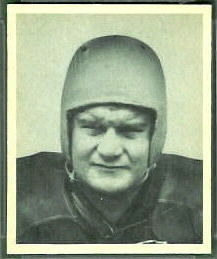 The 1948 Bowman cards are small, nearly square, and black-and-white. The cards picture the current players of the time, and since no one had printed football cards since National Chicle in 1935, every card in the 1948 Bowman set is a rookie card. The cards have no printing on the front, only on the back, a format I really like. Every third card–that is, each card with a number divisible by three–is considered a short print. This, says my old Beckett catalog, is because the sheet they were printed on was “printed in much lesser quantities” than the other two sheets. Judging by PSA’s population report, the “lesser” is accurate, but the “much” is not: PSA has graded about third fewer of the short prints, not enough to justify the 4x to 5x premium that Beckett assigns to them.
The 1948 Bowman cards are small, nearly square, and black-and-white. The cards picture the current players of the time, and since no one had printed football cards since National Chicle in 1935, every card in the 1948 Bowman set is a rookie card. The cards have no printing on the front, only on the back, a format I really like. Every third card–that is, each card with a number divisible by three–is considered a short print. This, says my old Beckett catalog, is because the sheet they were printed on was “printed in much lesser quantities” than the other two sheets. Judging by PSA’s population report, the “lesser” is accurate, but the “much” is not: PSA has graded about third fewer of the short prints, not enough to justify the 4x to 5x premium that Beckett assigns to them.
1950 Bowman
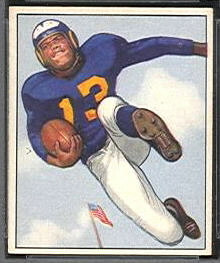 The 1950 Bowmans are the same size as the 1948 cards, and they look like little oil paintings. Like the 1948 cards, they have printing only on the back. 1950 was the year that the All-American Football Conference folded and three of its teams–the Baltimore Colts, Cleveland Browns, and San Francisco 49ers–joined the NFL. Because no major card company had printed cards of AAFC players, several of the stars from the AAFC made their football card debut in the 1950 Bowman set. Of the 10 Hall of Fame players whose rookie cards appear in the 1950 Bowman set, 6 came from the AAFC, and 4 of those 6 played for the Browns.
The 1950 Bowmans are the same size as the 1948 cards, and they look like little oil paintings. Like the 1948 cards, they have printing only on the back. 1950 was the year that the All-American Football Conference folded and three of its teams–the Baltimore Colts, Cleveland Browns, and San Francisco 49ers–joined the NFL. Because no major card company had printed cards of AAFC players, several of the stars from the AAFC made their football card debut in the 1950 Bowman set. Of the 10 Hall of Fame players whose rookie cards appear in the 1950 Bowman set, 6 came from the AAFC, and 4 of those 6 played for the Browns.
The Los Angeles Rams were the first team to put a logo on their helmets, and this might be why most of the Rams are wearing helmets on their 1950 Bowman cards. The artist who colored the cards took liberties with the colors, however. On the cards the Rams’ horns appear white in the front and yellow in back, but on the actual helmets the horns did not change color somewhere in the middle.
1951 Bowman
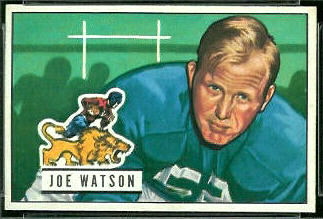 In 1951, Bowman enlarged the cards and put the player’s name and team logo on the front. The logos overwhelm the cards a bit, but logos were more intricate back then, and they needed to be large to show the detail. (See the Lions and Giants logos, for example.) Though attractive, the 1951 set seems to be less popular than the 1950 and 1952 sets, perhaps because it has fewer rookie cards of prominent players.
In 1951, Bowman enlarged the cards and put the player’s name and team logo on the front. The logos overwhelm the cards a bit, but logos were more intricate back then, and they needed to be large to show the detail. (See the Lions and Giants logos, for example.) Though attractive, the 1951 set seems to be less popular than the 1950 and 1952 sets, perhaps because it has fewer rookie cards of prominent players.
1952 Bowman Large
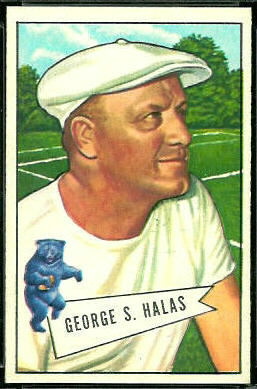 In 1952, Bowman released two sets of football cards, identical except for their size. An article in the PSA Library provides a detailed description of the 1952 Large set. In addition to the rookie cards of several Hall of Fame players, the set includes the rookie cards of three Hall of Fame coaches: George Halas, Paul Brown, and Steve Owen. Some cards in the set are challenging to find in high grades: cards with numbers divisible by 9 and the cards immediately following them (i.e., 10, 19, 28, …) are reportedly short prints, and PSA’s population report indicates that some of the other cards (#70, Gene Schroeder, for example) are actually as scarce as the designated short prints.
In 1952, Bowman released two sets of football cards, identical except for their size. An article in the PSA Library provides a detailed description of the 1952 Large set. In addition to the rookie cards of several Hall of Fame players, the set includes the rookie cards of three Hall of Fame coaches: George Halas, Paul Brown, and Steve Owen. Some cards in the set are challenging to find in high grades: cards with numbers divisible by 9 and the cards immediately following them (i.e., 10, 19, 28, …) are reportedly short prints, and PSA’s population report indicates that some of the other cards (#70, Gene Schroeder, for example) are actually as scarce as the designated short prints.
The PSA article says that the most valuable card in the set is #144, Jim Lansford. The article is correct: the price guides list the card at 2-to-5 times the value of the next most valuable card. Why? Well, the price guides say, not only is the Lansford a short print, but it’s the dreaded last card in the set! This to me is another example of where the guides are off base, since numerous other cards in the set are at least as scarce as the Lansford. (For more “last card” silliness, see my 1959 Topps virtual uncut sheet.)
1952 Bowman Small
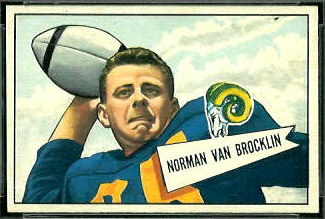 The 1952 Bowman Small cards, except for their size, are identical to the Large cards. The PSA library also has an article on this set. It appears that Bowman printed fewer Smalls than Larges, but collectors evidently prefer the large format, because the Larges, in general, command higher prices. Because they fit differently on the sheet, the Smalls do not have the same distribution as the Larges, and no Smalls are designated short prints.
The 1952 Bowman Small cards, except for their size, are identical to the Large cards. The PSA library also has an article on this set. It appears that Bowman printed fewer Smalls than Larges, but collectors evidently prefer the large format, because the Larges, in general, command higher prices. Because they fit differently on the sheet, the Smalls do not have the same distribution as the Larges, and no Smalls are designated short prints.
1953 Bowman
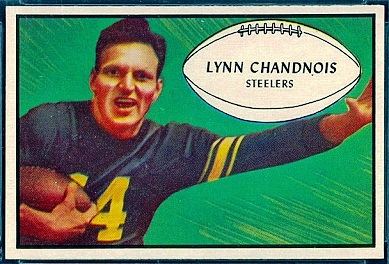 Bowman’s follow-up to their classic 1952 sets was the disappointing 1953 Bowman set. In a previous article, I wrote about the ugly white football on the front of the cards, but that’s not the only problem. Outside of the white football, the cards are dark–often too dark to get a good scan–and there is not a single significant rookie card in the set. The card distribution is strange, too: there are 96 cards in the set, and only two of them are Packers.
Bowman’s follow-up to their classic 1952 sets was the disappointing 1953 Bowman set. In a previous article, I wrote about the ugly white football on the front of the cards, but that’s not the only problem. Outside of the white football, the cards are dark–often too dark to get a good scan–and there is not a single significant rookie card in the set. The card distribution is strange, too: there are 96 cards in the set, and only two of them are Packers.
1954 Bowman
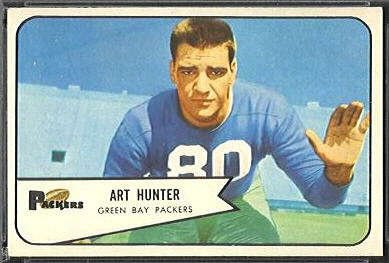 1954 Bowman football cards are the plainest of the old Bowmans, but they are colorful, clear, and attractive. Cards 65-96 were clearly printed in smaller numbers, but my old Beckett has them priced five times higher than the other cards, which is excessive. My favorite is Jim Dooley, in his College All-Star uniform. There is a Whizzer White in the set, but he’s not the Supreme Court justice. There’s an old thread about the Whizzers on the Collectors Universe message board.
1954 Bowman football cards are the plainest of the old Bowmans, but they are colorful, clear, and attractive. Cards 65-96 were clearly printed in smaller numbers, but my old Beckett has them priced five times higher than the other cards, which is excessive. My favorite is Jim Dooley, in his College All-Star uniform. There is a Whizzer White in the set, but he’s not the Supreme Court justice. There’s an old thread about the Whizzers on the Collectors Universe message board.
1955 Bowman
 Finally, there are the 1955 Bowmans. Bowman got experimental again with this set, putting each player on a colored background and giving him an aura. All of the players on a given team have the same colored background: the background for the Packers is yellow, for example, and the background for the Giants is green. I like the uniformity that the background brings to this set. In 1953 and 1954, Bowman put some players on solid color backgrounds, some on geometric backgrounds, and some in front of trees and shrubs.
Finally, there are the 1955 Bowmans. Bowman got experimental again with this set, putting each player on a colored background and giving him an aura. All of the players on a given team have the same colored background: the background for the Packers is yellow, for example, and the background for the Giants is green. I like the uniformity that the background brings to this set. In 1953 and 1954, Bowman put some players on solid color backgrounds, some on geometric backgrounds, and some in front of trees and shrubs.
In 1956, Topps bought Bowman Gum, and Bowman’s run of football cards ended. Now that I think of it, don’t 1956 Topps football cards look like a hybrid of 1955 Bowman and 1955 Topps cards? The 1956 Topps cards have the player on a colored background, with a bit of an aura, and the logo box looks just like the one on the 1955 Topps All-Americans.
- Previous: A is for All-Americans
- Next: C is for Checklists
- All of the ABCs

August 12th, 2009 at 6:39 AM (#)
This is a great article. I like that you gave info, opinions, and little snip-bits of pricing issues for each classic Bowman set. Very well presented.
Your websites are a wealth of great information on vintage football cards. Keep up the GREAT WORK!!!
August 12th, 2009 at 6:58 AM (#)
Thanks, Dave, I appreciate the encouragement. I check out your blog regularly, too.
August 27th, 2009 at 4:37 PM (#)
Thanks, I really enjoyed reading about the early Bowmans. It’s nice, pointed, concise information and I seem to agree with most of the opinions. Early Bowman football are my favorite cards to collect.
August 27th, 2009 at 6:37 PM (#)
Hi Keith, thanks for the compliment. Glad to see you checking in!
September 17th, 2009 at 10:49 AM (#)
[…] here is Romanik’s 1952 Bowman Large card, one of the divisible-by-9 short prints. (See B is for Bowman.) He also appeared on a 1952 Bowman Small card, identical except for its size. Tags: 1952 Bowman […]
December 21st, 2009 at 7:07 PM (#)
Was a card ever made for Bob Hecker from Baldwin Wallace College? He was a rookie in 1949 for the Chicago Cardinals and later played for the Rams with his brother Norb Hecker.
December 21st, 2009 at 10:01 PM (#)
Not that I’m aware of, Tim. The card companies typically printed cards of only a few players per team.
January 14th, 2010 at 1:41 PM (#)
Boy am I stumbled on your Blog Site – absolutely fantastic and as informative as can be – congratulations and THANKS – I will be back on a regular basis, Bud.
January 14th, 2010 at 3:42 PM (#)
Thanks, Bud–glad to have you here!
April 3rd, 2010 at 7:34 AM (#)
I love the old Bowman’s. Have a few full sets. Know what other set I really like? 1948 Leaf Football. Talk about neat looking cards…and almost impossible to get fully centered…now there is a real challenge. I like your writing and I sure like doing business with you. Keep it up. Kent
March 20th, 2011 at 2:17 PM (#)
Hi Nearmint
Love your site and was wondering if you would like high quality scans of some of my sets that are missing on your vintage football site:
1969 Eskimo Pie (12 diff.)
1961-64 Kahns (complete)
1959 Kahns Jim BROWN
1960 Kahns Jim Brown, Willie Davis
1959 Bazooka (complete)
1971 Bazooka panels (complete)
1964 Wheaties stamps (complete)
If you are missing other scans from various sets, there is a good chance i have them in my collection and would be happy to get them to you to further establish your site as the definitive football card reference site. Please let me know fairly soon as i may be selling my collection in the next month or two.
thanks
Mike Ford
supplex55
April 13th, 2011 at 10:10 AM (#)
Mike, I was wondering if you interested in selling or trading the 1969 eskimo pie panels. I need four to complete the set. Pleases let me know thanks Jason
May 4th, 2011 at 5:54 AM (#)
[…] well, I have never been fond of this issue, anyway. (See my posts on the early Bowman sets and the NFL’s use of white footballs.) The odd player selection is just another reason to […]
November 30th, 2012 at 8:27 PM (#)
As the 1st negro to play in Cotton Bowl,Dallas, Texas and drafted and play in the NFL I have card #189 in a Series of Football Picture Cards of 1950 Bowman Gum,Inc. Phila.Pa.. It is “2 1/2” square and in color with my Penn State #18 and blue & white jersey. What is this card worth ?
November 30th, 2012 at 8:47 PM (#)
Hello, Mr. Triplett. It depends on how worn the card is. In nearmint condition, it is worth $25-35. Here is a link to the card:
http://www.footballcardgallery.com/1950+Bowman/109/Wallace_Triplett/